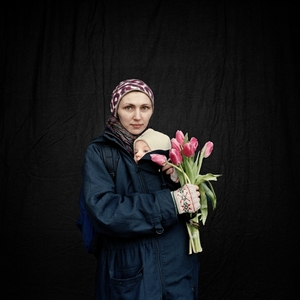Anastasia Taylor-Lind: When Failure Leads to Success

|
|
|
When Taylor-Lind arrived in Benghazi, she found herself in an unfamiliar situation—surrounded by news photographers covering a rapidly unfolding story. She, on the other hand, was used to working alone on long-range magazine projects using a medium-format camera and color film. “I couldn’t get a handle on how to photographically approach the subject and say something in my own way,” she says. “After a week and a half there, I told my friends, ‘That’s it, I’m going home.’”
Before leaving, she briefly considered the idea of setting up a makeshift studio in her hotel and shooting portraits of the other journalists there. In the end, she told herself that she wasn’t a studio portrait photographer, that in any case she didn’t know how to set up a makeshift studio, and moved on.
Three years later, she found herself in a similar situation in Ukraine, when, in February 2014, clashes erupted in Kiev’s central square, the Maidan Nezalezhnosti. Taylor-Lind had come to the country to work on an ongoing project about declining populations in Europe but had landed in the middle of another revolution being covered by news photographers from around the world. Looking for a way to capture the scene, she remembered the idea she’d had in Libya and set up a makeshift studio in the Maidan. She began shooting portraits of journalists but soon was making portraits of Ukrainian fighters. Then she began photographing the women who came to mourn those killed in the fighting.
The result was a remarkable series of images that reveal conflict and its costs in a new way. For Taylor-Lind, the work also represented a career breakthrough: For the past decade, she had been shooting for National Geographic, Time, The New York Times, and other publications. That wasn’t an option in Ukraine. “With the Maidan story, the only way to get it out there was through social media,” she says.
To that end, she added a twist to her work: As her subjects sat for portraits, she used an iPhone to shoot photos and videos of them through the viewfinder of her Bronica. Those she shared on Instagram, even as the upheaval in the Maidan was going on. Because of the interest she built online, the book publisher Gost later came to her with the idea of producing a limited-edition collection of her medium-format portraits.
The book, Maidan—Portraits from the Black Square, was released last July to wide acclaim. Then, in October, Taylor-Lind was named to the 2014 class of TED Fellows; her TED Talk describing the Maidan project was released in December. “It’s yet another way I’m able to share the work,” she says.
Gently Observed Portraits In Soft Light
Though she found new ways to distribute the work, the images Taylor-Lind made in Ukraine can be seen as a natural extension of what she’s been doing since studying photography at the University of Wales, Newport. She describes her brand of documentary photography as “gently observed portraits in soft light with pastel colors shot on medium-format film with a waist-level viewfinder.”
Taylor-Lind decided to become a photojournalist in high school, after a childhood spent wandering through the southwestern UK in a horse-drawn wagon with free-spirited parents. “My motivation was simple,” she says. “I wanted to find a way to travel the world and continue in some way the wonderful aspects of my childhood, which involved meeting strangers and drinking tea with them on a fairly regular basis. Except I could get paid for doing it.”
Her big break came near the end of her college career, when she traveled to Kurdistan—she’d heard about the place from her father, who, she says, “traveled on the hippie trail from India to Britain”—and shot portraits of Peshmerga women fighters on the Turkish border. “I took one beautiful portrait that later won a photo contest sponsored by the Guardian newspaper,” she says. The contest’s judge, David Bailey, likened the photo to Alberto Korda’s iconic portrait of Che Guevara.
“I had no idea it was good,” she says. “It takes a long time to learn your craft as a photographer. Many young photographers take great pictures, but there’s a difference between taking a great picture and knowing that it’s a great picture. And that’s something I’ve only been able to recognize in the last five years.”
Taylor-Lind has gone on to receive a number of awards, including the Magenta Foundation Emerging Photographers Award. This year, photos she shot for a Wired magazine story on female polio vaccinators working in Afghanistan were included in the American Photography 30 annual.
In the past year, besides shooting her remarkable story in Kiev, Taylor-Lind was commissioned to return to northern Iraq to once again photograph Peshmerga fighters. "I had only two days there, but I was able to find all the work prints I’d made from that trip 11 years before, and I was able to locate some of the women I’d photographed then and give them the pictures I'd made," she says.
And in November Taylor-Lind launched a series of two-day workshops for young photographers in her apartment in London’s Brixton neighborhood. In January, she brought the workshop to Brooklyn’s Ten Ton Studios. Among other things, she discussed her own failed projects with her students. “Creativity is connecting dots that are seemingly un-connectable,” she says.


